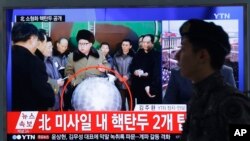North Korean leader Kim Jong Un Tuesday says his country will conduct tests of nuclear warheads and ballistic missiles "in a short time," continuing a pattern of loud defiance of the international community.
This latest threat is consistent with Pyongyang’s recent responses to tough new United Nations sanctions imposed upon it, and seems to be directed at skeptics who doubt the North’s nuclear capabilities.
The state-run Korean Central News Agency (KCNA) reported that Kim ordered further nuclear and missile tests while witnessing a demonstration of heat-resistant materials to be used in ballistic missiles for atmospheric re-entry.
According to KCNA, Kim said “a nuclear warhead explosion test and a test-fire of several kinds of ballistic rockets able to carry nuclear warheads will be conducted in a short time to further enhance the reliance of nuclear attack capability.”
Urging restraint
Both South Korea and Japan have urged North Korea to refrain from further violating the United Nations Security Council resolution banning Pyongyang from developing its nuclear weapons and ballistic missile technology.
South Korean President Park Geun-Hye Tuesday said that if “North Korea will lead itself to self-destruction if it does not change and continues to make
excessive provocations and confrontation with the international community.”
"We absolutely cannot allow North Korea to continue on with its provocative attitude and not abandon its nuclear missile development," said Japanese Chief Cabinet Secretary Yoshide Suga.
At the same time, Seoul discounts Pyongyang’s claim that it has developed missile re-entry technology.
“What North Korea announced today was North Korea’s one-sided claim. Based on what our military has judged so far, North Korea has not obtained re-entry capability," said South Korean Defense Ministry spokesman Moon Sang-kyun.
Unverifiable tests
North Korea has conducted four nuclear tests, and claimed its last test in January was of a significantly more powerful hydrogen bomb. But a number of experts said the blast, recorded by earthquake detectors, was too small for an H-bomb.
The North says the satellites it has launched into orbit are functioning successfully, although that has not been verified independently.
There is also widespread skepticism over North Korea’s claims that it has successfully miniaturized a nuclear warhead to be mounted on an intercontinental ballistic missile and that it has acquired the re-entry technology needed for a long-range missile to bring a payload back into the atmosphere.
North Korea does have the KN-08 missile that is estimated to have a range of several thousand kilometers.
But to date there have been no verifiable tests to demonstrate either long range missile or miniaturized nuclear warhead capabilities.
Credible claims
KCNA published pictures of an object described as a warhead tip, a dome-shaped object placed under what appeared to be a rocket engine and being blasted with flaming exhaust.
The photos could be mock ups intended to make the world think North Korea’s nuclear program is more advanced that it is, said analyst Kim Dong-yub, with Kyungnam University's Institute of Far Eastern Studies in Seoul.
“By looking at the shape, many think North Korea has completed miniaturization, but I am still skeptical whether the object is a model or is explosive,” he said.
But given the advancement of the North's nuclear program in the last decade, he said, it is reasonable to conclude they have made significant progress in developing warhead miniaturization capability.
North Korea nuclear analyst Jeffrey Lewis agrees and said the photos and North Korea’s nuclear claims seem credible.
“That would not be unusual for a state that has run four nuclear tests to be able to build a fission device with say about 60 centimeters in diameter, which should fit on the end of one of their missiles,” said Lewis, who is director of the East Asia Nonproliferation Program at the Middlebury Institute of International Studies in California.
North Korea is believed to have enough plutonium to make eight to 12 nuclear bombs as well as has a stockpile of highly enriched uranium. An expanding network of tunnels has also been detected in the area where past nuclear blasts have been detonated, presumably in preparation for more tests.
North Korea has responded with defiance to new U.N. sanctions imposed this month after its nuclear test in January was followed by a long-range rocket launch in February.
This week Pyongyang claimed it could wipe out Manhattan by burning it "down to ashes" using a hydrogen bomb on a ballistic missile and last week it threatened a pre-emptive nuclear strike against U.S. and South Korean forces that are engaged in their annual joint military drills on the Korean peninsula.
The photos North Korea released and the tests it is planning, Lewis said, seems intended to remove any doubt over its alleged nuclear capabilities.
“What it looks like to me is the North Koreans are sort of methodically going through all the places that we expressed skepticism about, and they are releasing pictures and I suspect that will culminate in this last round of tests,” he said.
The new U.N. Security Council resolution expanded existing sanctions by requiring member states to inspect all cargo to and from North Korea and banning the North's trade of coal when it is seen as funding the country’s arms program.
North Korea has been unwilling to yield to the demands of the international community, even from China, its key ally and economic partner.
Instead, the Kim Jong Un government maintains it has a sovereign right to a nuclear deterrent to defend itself from threats, and to run a space program putting satellites into orbit.
Youmi Kim in Seoul contributed to this report.



